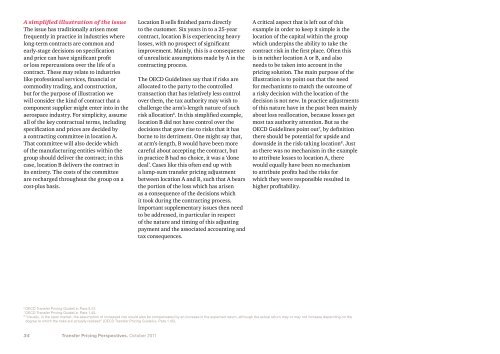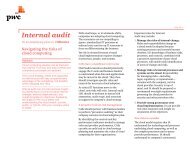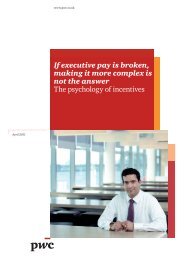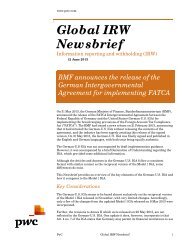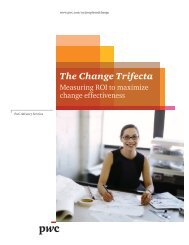Transfer pricing perspectives: Winds of Change - PwC
Transfer pricing perspectives: Winds of Change - PwC
Transfer pricing perspectives: Winds of Change - PwC
You also want an ePaper? Increase the reach of your titles
YUMPU automatically turns print PDFs into web optimized ePapers that Google loves.
A simplified illustration <strong>of</strong> the issueThe issue has traditionally arisen mostfrequently in practice in industries wherelong‐term contracts are common andearly‐stage decisions on specificationand price can have significant pr<strong>of</strong>itor loss repercussions over the life <strong>of</strong> acontract. These may relate to industrieslike pr<strong>of</strong>essional services, financial orcommodity trading, and construction,but for the purpose <strong>of</strong> illustration wewill consider the kind <strong>of</strong> contract that acomponent supplier might enter into in theaerospace industry. For simplicity, assumeall <strong>of</strong> the key contractual terms, includingspecification and prices are decided bya contracting committee in location A.That committee will also decide which<strong>of</strong> the manufacturing entities within thegroup should deliver the contract; in thiscase, location B delivers the contract inits entirety. The costs <strong>of</strong> the committeeare recharged throughout the group on acost‐plus basis.Location B sells finished parts directlyto the customer. Six years in to a 25-yearcontract, location B is experiencing heavylosses, with no prospect <strong>of</strong> significantimprovement. Mainly, this is a consequence<strong>of</strong> unrealistic assumptions made by A in thecontracting process.The OECD Guidelines say that if risks areallocated to the party to the controlledtransaction that has relatively less controlover them, the tax authority may wish tochallenge the arm’s-length nature <strong>of</strong> suchrisk allocation 6 . In this simplified example,location B did not have control over thedecisions that gave rise to risks that it hasborne to its detriment. One might say that,at arm’s-length, B would have been morecareful about accepting the contract, butin practice B had no choice, it was a ‘donedeal’. Cases like this <strong>of</strong>ten end up witha lump‐sum transfer <strong>pricing</strong> adjustmentbetween location A and B, such that A bearsthe portion <strong>of</strong> the loss which has arisenas a consequence <strong>of</strong> the decisions whichit took during the contracting process.Important supplementary issues then needto be addressed, in particular in respect<strong>of</strong> the nature and timing <strong>of</strong> this adjustingpayment and the associated accounting andtax consequences.A critical aspect that is left out <strong>of</strong> thisexample in order to keep it simple is thelocation <strong>of</strong> the capital within the groupwhich underpins the ability to take thecontract risk in the first place. Often thisis in neither location A or B, and alsoneeds to be taken into account in the<strong>pricing</strong> solution. The main purpose <strong>of</strong> theillustration is to point out that the needfor mechanisms to match the outcome <strong>of</strong>a risky decision with the location <strong>of</strong> thedecision is not new. In practice adjustments<strong>of</strong> this nature have in the past been mainlyabout loss reallocation, because losses getmost tax authority attention. But as theOECD Guidelines point out 7 , by definitionthere should be potential for upside anddownside in the risk‐taking location 8 . Justas there was no mechanism in the exampleto attribute losses to location A, therewould equally have been no mechanismto attribute pr<strong>of</strong>its had the risks forwhich they were responsible resulted inhigher pr<strong>of</strong>itability.6OECD <strong>Transfer</strong> Pricing Guideli.e. Para 9.22.7OECD <strong>Transfer</strong> Pricing Guideli.e. Para 1.45.8“Usually, in the open market, the assumption <strong>of</strong> increased risk would also be compensated by an increase in the expected return, although the actual return may or may not increase depending on thedegree to which the risks are actually realised” (OECD <strong>Transfer</strong> Pricing Guideli.e. Para 1.45).34 <strong>Transfer</strong> Pricing Perspectives. October 2011


